#john byrne is a bigot
Text
The Retconning of Aunt May's death from Amazing Spider-Man #400... aka, screw John Byrne!
Wanna know something else we can criticize John Byrne for aside from his general creepiness and bigotry? He undid Aunt May’s death in the beautifully written Amazing Spider-Man (1963) #400, "The Gift," aka one of the best stories to come out of the entire infamous Clone Saga era.

Like... when Linkara reviewed the Web of Death storyline, one particular complaint he brought up was how all of the all the beautiful & emotional moments between Peter Parker and comatose Aunt May were severely undermined in hindsight due to the later retcon that this wasn't actually May Parker, but instead an highly-skilled actress whom Norman Osborn replaced Aunt May with after her stroke and made resemble Peter's aunt through cloning technology.
youtube

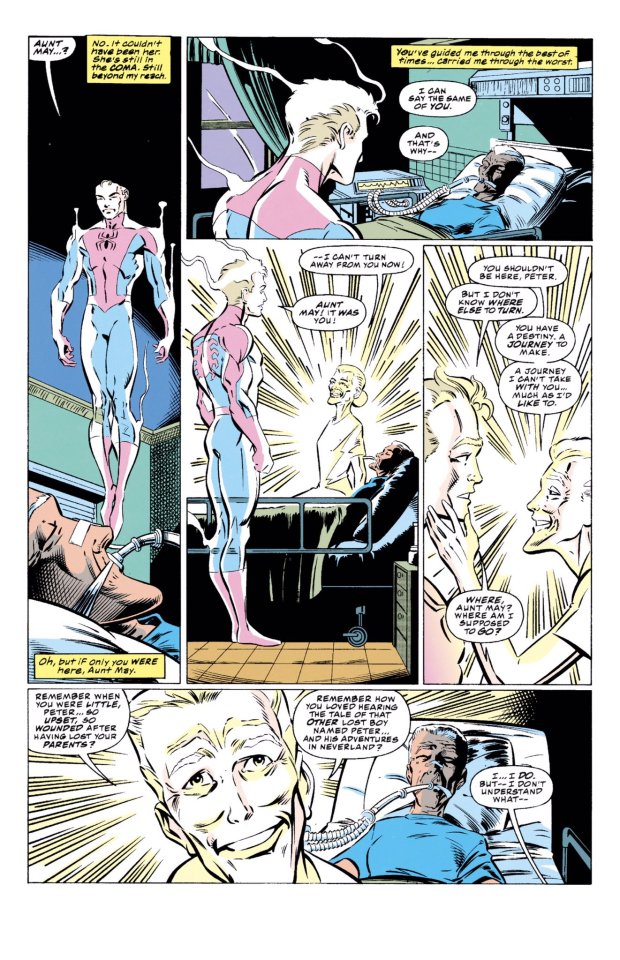
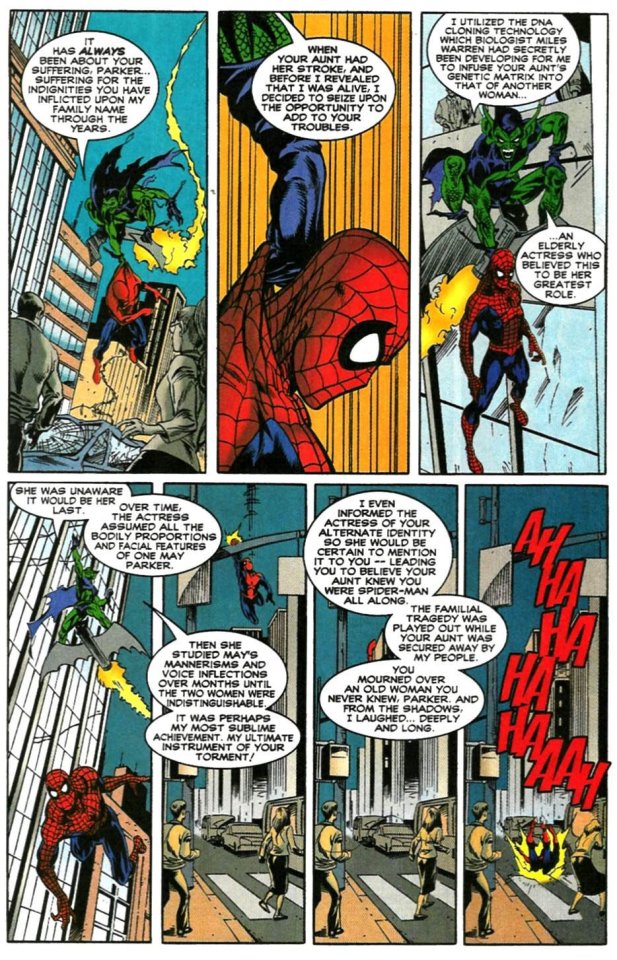
And the person who was responsible for this controversial retcon? None other than John Byrne!
Byrne apparently refused to even initiate his divisive 1999 Chapter One and The Next Chapter reboots of the Spider-Man titles unless he was allowed to utilize Aunt May as a member of Peter's supporting cast. Consequently, this meant completely retconning Aunt May's lovely and tragic send-off by J.M. DeMatteis & Mark Bagley in ASM #400, even though that issue was highly regarded and celebrated by even the most hardened detractors of The Clone Saga era as a whole.

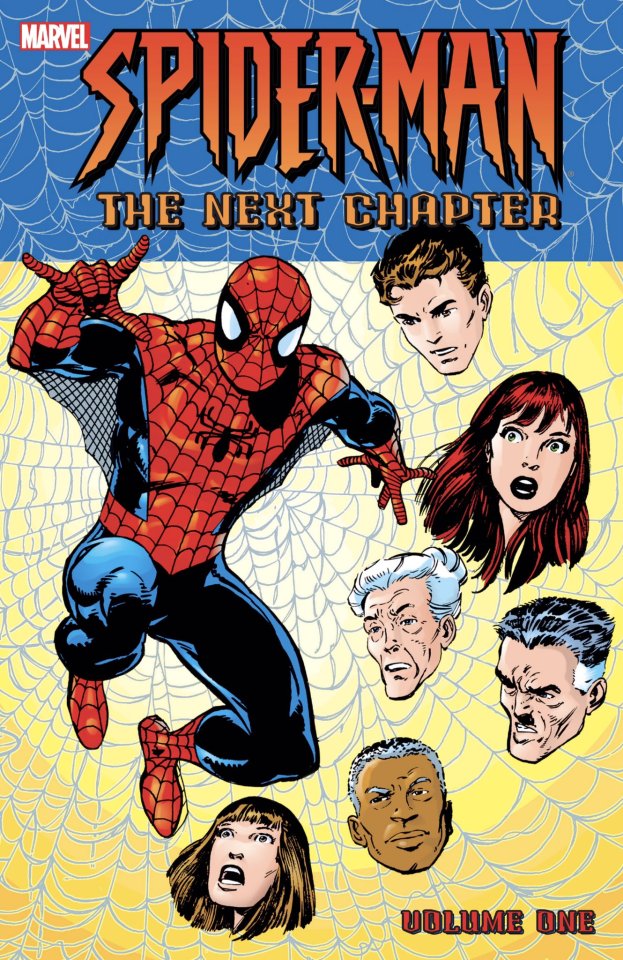
And you know what made the retconning of Aunt May's death even more stupid? It directly contradicted Norman Osborn's own recounting of The Clone Saga from his perspective in The Osborn Journal one-shot after he was revealed to be the true mastermind behind the whole saga. Writer & editor Glenn Greenberg specifically made sure to include these passages from Norman's private journals:
-"And as luck would have it, the clone -- Reilly -- learned of May Parker's stroke and returned to New York to be near her during her final days. This saved me the trouble of concocting some elaborate scheme to lure him back to the city."
-"Then the old woman finally died, delivering a major emotional blow to Parker and his wife. My only regret is that I was NOT the cause."

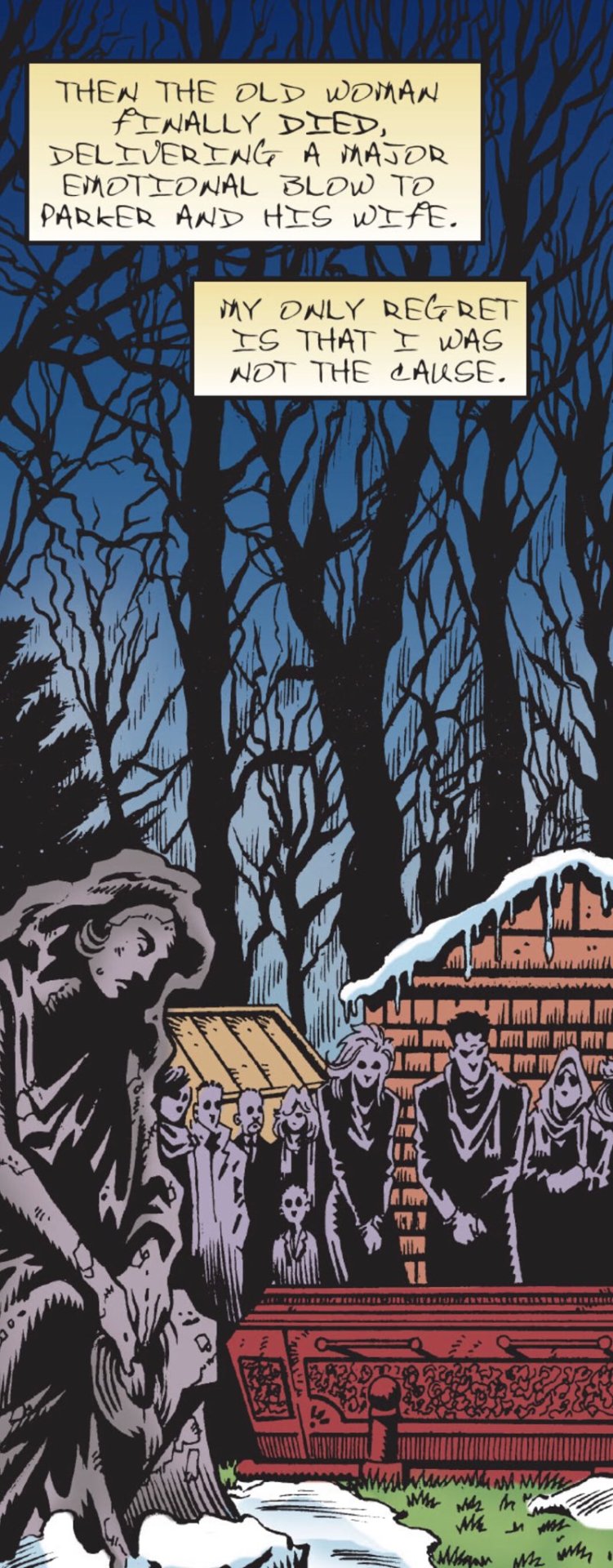
Yup, Greenberg wanted to make sure that DeMatteis' brilliant work from ASM #400 wouldn't be undone by having Norman himself state in his private journals that May's death was strictly due to natural causes instead of another part of his behind-the-scene's manipulations. Which makes sense considering that the entire issue was dedicated to Peter & Aunt May's final days together as she revealed to her nephew that she had always known he was Spider-Man and was deeply proud of him before passing away in her bed right besides Peter, Mary Jane & Aunt Anna, with Peter's final words to his surrogate mother-figure being him quoting his favorite childhood novel Peter Pan to her, telling Aunt May:
"Let go. Fly. 'Second to the right... and straight on until morning.'"
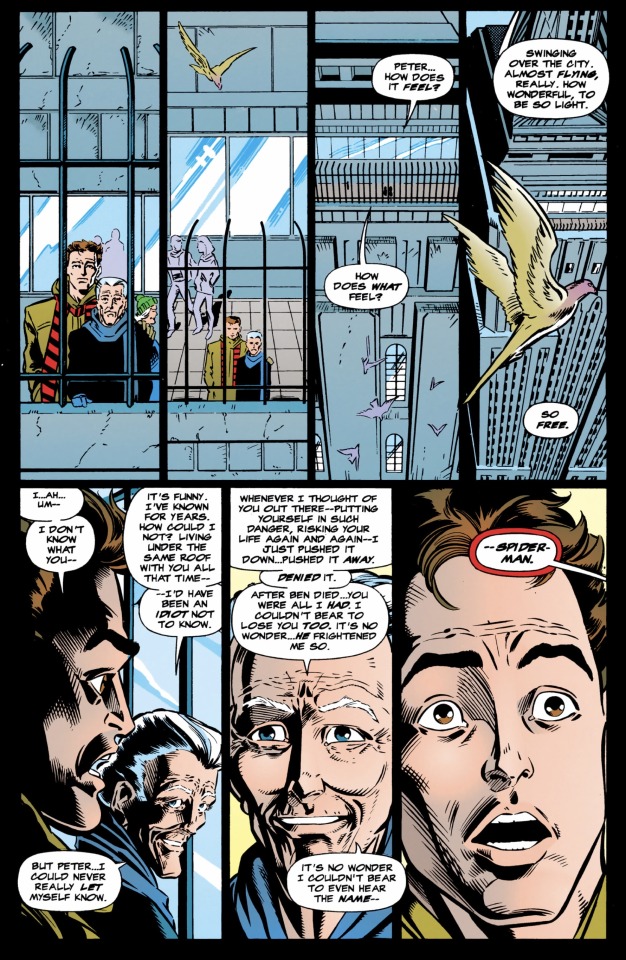



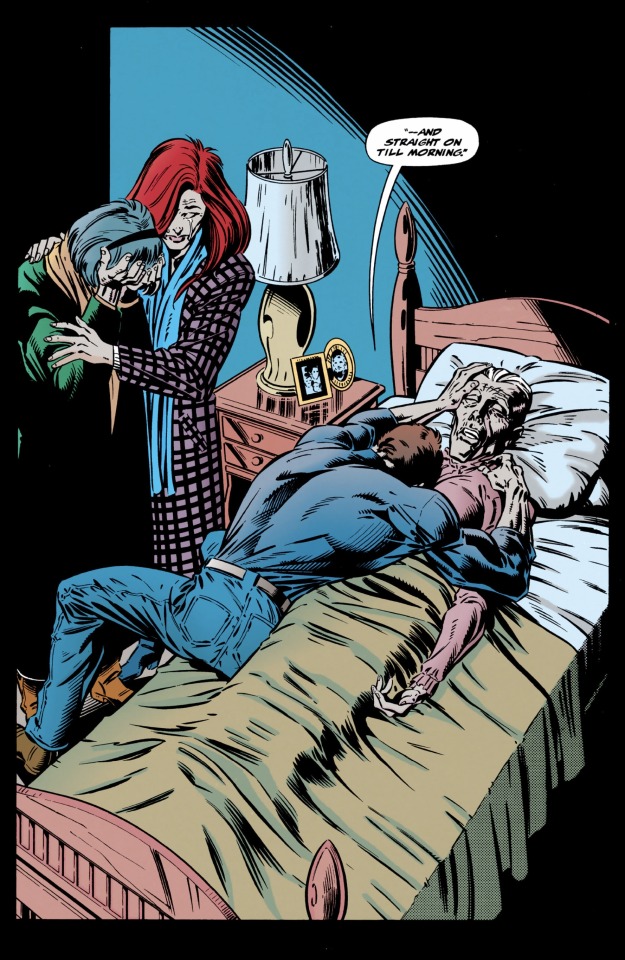

Its honestly one of the most simultaneously heartbreaking & beautiful scenes that I've personally ever read in a comic. The silent panels of Ben Reilly crying to himself on the roof of the house, unable to be by his Aunt's side during her final moments since he's only a clone of her nephew, especially tug at my heartstrings (poor Benjy)! And its an issue that resonates with me even more deeply today than back when I initially read it a few years ago, since I now know what it feels like to lose a dearly beloved relative, with both my paternal grandmother (Nana) and maternal grandfather (Paps) having since passed away.
But then John Byrne decided in his infinite wisdom to screw it all up, ignoring all of that emotional weight and feelings of down-to-Earth loss by not only revealing that the Aunt May Peter watched die was actually just a random actress whom Norman Osborn "genetically modified via the Jackal’s cloning technology" (which again… makes ZERO sense), but that Osborn apparently now lied in his own personal diaries or something?

So yeah, the resurrection of Aunt May by John Byrne during the Spider-Man: The Gathering of Five/The Final Chapter arcs is easily one of the most insulting retcons that I've ever encountered since it spits in the face of one of the most beautifully written single-issues that I've personally ever read (both because of how it personally resonates with me as someone who's lost two grandparents, and because is J.M. DeMatteis is among my Top 5 favorite comic book writers).
But trust me, this is the LEAST of John Byrne's problems, which fellow comic creator Ramon Villalobos made an excellent thread discussing in detail if you want further information:
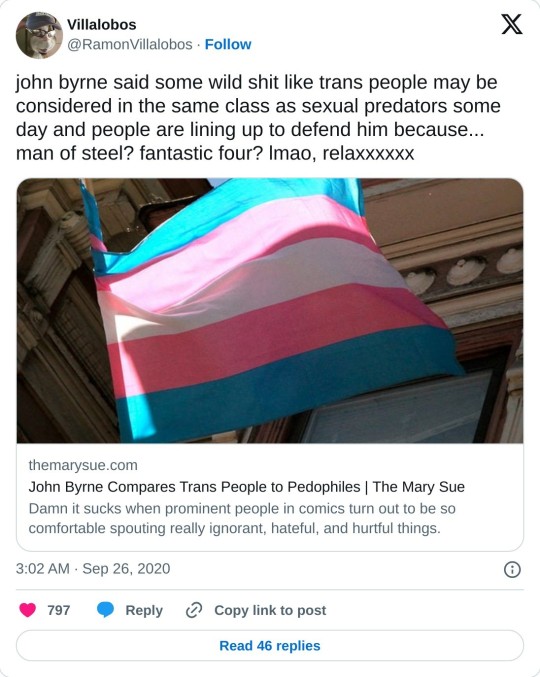

#spider man#aunt may#may parker#screw john byrne#john byrne is a creep#john byrne is a bigot#the death of aunt may#the gift#the gathering of five#the final chapter#the osborn journal#clone saga#90s comics#jm dematteis#mark bagley#glenn greenberg#norman osborn#green goblin#scarlet spider#ben reilly#tangent#marvel comics#Youtube#linkara#ramon villalobos#mini essay
12 notes
·
View notes
Note
i saw you mention it in the tags of a post but what are your thoughts on john byrne's superman?
not the biggest fan tbh! john byrne is a very bigoted right-wing cunt and a LOT of that bleeds through into his writing.
probably the biggest thing i (and many other people) hate about his superman is how he restructured clark’s origin to strip away the immigrant allegory. the origin for byrne’s superman is that while he was created in a birthing matrix on krypton by jor-el and lara, he was actually born on earth to jonathan and martha kent—and that's the MOST important thing to him:
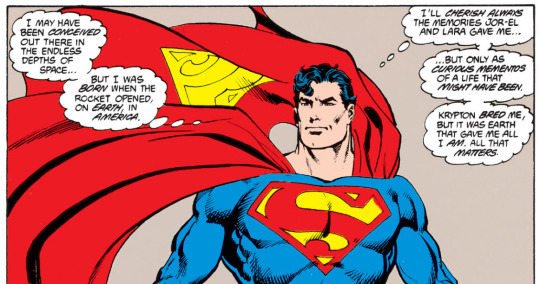
the man of steel #6
and throughout his run byrne just smacks you over the head with clark as a Proud American (and as a "super-republican", as byrne once described him), and constantly has him reiterate that his kryptonian heritage just isn't important to him. idk i just think it's so shitty to take a character who was purposely created to parallel and represent the lives of jewish immigrants and strip those meaningful aspects away from him.
so that's basically what i was referring to with my tags (i had said that pre-crisis kara should've materialized as a spirit and beat this clark's ass)—even in pre-crisis, kara's someone who will never forget krypton and never stop being a kryptonian, and even though she had assimilated into american society that didn't mean that she didn't care or think about her heritage:

supergirl (1982) #17
and that's ultimately just difference between paul kupperberg (a jewish writer who understood the history of these characters and knew what they were intended to represent) vs. john byrne (cunt).
all that being said, there are definitely things that i enjoy from byrne's run on superman. i honestly didn't hate how he wrote most of the daily planet employees and i really liked all the different dynamics between them. i also really enjoy his art for the most part and i especially love how he draws clark vs how he draws superman (and i love his lois, jimmy, and cat grant). but yeah that's pretty much all i like from him lol.
#asks#kara zor el#clark kent#he's also such a scumbag irl (xenophobic/transphobic/ableist/etc etc) that it definitely informs how i interact w his comics#wishing ill on john byrne forever
12 notes
·
View notes
Text
Fantastic Four Vol 1 #242
Mon Dec 21 2020
[12:25 AM] Wack'd: FANTASTIC FOUR VOL 1 NO 242
[12:27 AM] Wack'd: A weird assortment

[12:27 AM] Wack'd: Was this an Avengers lineup at some point or what
[12:28 AM] maxwellelvis: Probably a Defenders one
[12:28 AM] Wack'd: That makes more sense yeah
[12:28 AM] maxwellelvis: but then, who hasn't been a Defender at this point?
[12:29 AM] Wack'd: I invite you to read this in the voice of the Amazing World of Ghosts narrator

[12:29 AM] maxwellelvis: "Could this supernova be the work of ghosts from the sixth dimension?"
[12:30 AM] Wack'd: So it turns out this meteor is driven by Terrax. This is a very grandiose and philosophical introduction for such a stupid character whose main appeal, to this point, has been having no real interiority whatsoever
[12:32 AM] Wack'd: Meanwhile in the Baxter, Sue is upset that they need to throw out the Christmas tree, since it's so majestic
[12:32 AM] Wack'd: And then she's mad at Reed because it turns out it's a mechanical tree that folds itself up to be put away for next year
[12:33 AM] Wack'd: Reed is confused as to why she's upset and honestly for the first time in recorded history I'm with him on this
[12:33 AM] Wack'd: If you couldn't tell it was a fake looking at it than it's fine, jesus
[12:33 AM] maxwellelvis: *shocked monkey puppet gif*
[12:34 AM] maxwellelvis: Just in shock that you're in agreement with Reed on something, ever.
[12:34 AM] Wack'd: Maybe I just have no time for arguments from authenticity about Christmas
[12:34 AM] Wack'd: I could give less of a shit
[12:35 AM] Wack'd: Also have this example of exemplary parenting

[12:35 AM] maxwellelvis: Oh, they still have Timmy
[12:35 AM] Wack'd: ...ohhhhh I misread the emphasis on that label
[12:35 AM] maxwellelvis: NOT A FLYING TOY
[12:36 AM] Wack'd: The joke is Franklin made it into a real missile
[12:36 AM] Wack'd: I thought the joke was it's not a toy but the joke is it's not supposed to fly
[12:36 AM] Wack'd: That's egg on my face
[12:36 AM] maxwellelvis: Buzz Lightyear is not a flying toy
[12:37 AM] Wack'd: Meanwhile Ben takes care of some very stupid muggers
[12:37 AM] Wack'd: And Johnny and Frankie are out on the town
[12:37 AM] maxwellelvis: Who looks at the 7-ft tall orange lump and thinks "Yeah, I can take him"?
[12:38 AM] Wack'd: They were apparently fooled by the hat and trenchcoat but he is still, again, 7-ft high and like three feet wide
[12:38 AM] maxwellelvis: He's a boulder with limbs!
[12:40 AM] Wack'd: Frankie and Johnny are going to visit Frankie's roommate who is in an off-off-Broadway production of...*googles*
[12:40 AM] Wack'd: ElfQuest??????
[12:41 AM] maxwellelvis: I see what you're doing there, Johnny B
[12:41 AM] Wack'd:


[12:41 AM] maxwellelvis: This was at a time when Marvel was the ones publishing ElfQuest
[12:42 AM] Wack'd: Huh!
[12:42 AM] maxwellelvis: before it went self-published.
[12:42 AM] maxwellelvis: @Bocaj would probably know more.
[12:43 AM] Wack'd: I don't have a joke here, this is just a neat effect

[12:45 AM] maxwellelvis: Like I've said tons of times, the hardest thing about John Byrne is that he IS talented, so it's not like most really disliked figures in the industry where you can point to obvious flaws in their writing or illustrations. It's just that his ego vastly outpaces his talent.
[12:45 AM] Wack'd: I feel like I've pointed out some pretty obvious flaws in his writing but to each their own
[12:45 AM] maxwellelvis: I mean, not everything anyone churns out will be good.
[12:46 AM] Bocaj: I read most of all of ElfQuest. It was actually self published first and then Marvel reprinted it. Except since ElfQuest had longer issues than Marvel standard, marvel just awkwardly cut at the right page length
[12:46 AM] maxwellelvis: Ah
[12:46 AM] Wack'd: Sure but not everything anyone churns out will be, uh
[12:46 AM] Wack'd: Grotesquely bigotted
[12:46 AM] Wack'd: Anyway
[12:47 AM] Wack'd: The Four plus Frankie reunite at the Baxter for the arrival of Terrax
[12:48 AM] Wack'd: You can correct me if I'm wrong but I'm pretty fucking sure this is the first time ever the Baxter Building has been fucking annihilated and it's wild to me we're spending this on friggin' Terrax

[12:48 AM] maxwellelvis: At least it's not Blastaar
[12:50 AM] Bocaj: Is he mad because they cost him a job?
[12:50 AM] maxwellelvis: Sounds like what he's ticked about.
[12:50 AM] Wack'd: I think he's pissed they got him that job, actually
[12:51 AM] Wack'd: Way back when the Four teamed up with Galactus to take out the Sphinx
[12:51 AM] maxwellelvis: SPHINX!
[12:51 AM] Wack'd: A condition was the Four would recruit his new Herald for him and he really wanted this fucker because he's so dang evil he wouldn't turn on him for being more evil
[12:52 AM] Wack'd: Anyway. Fight fight fight
[12:52 AM] Bocaj: I mean, it is kind of a dick move to get a guy into a contract he can't break
[12:53 AM] Wack'd: So Terrax' plan is, uh. Step one: get on top of the Twin Towers
[12:53 AM] Wack'd: *tugs collar*
[12:54 AM] Wack'd: Step two: do some kind of cosmic energy thing
[12:54 AM] maxwellelvis: Hoo boy, one of these situations again.
[12:54 AM] Wack'd: Sue uses her powers to turn Terrax' whatever-he's-doing visible, and he's. Uh. Put Manhattan in a big net?
[12:55 AM] maxwellelvis: BUTTERFLY NETS!
[12:56 AM] Wack'd: So! This issue promised some illustrious guest stars and the issue is almost over
[12:56 AM] Wack'd: Who doesn't love a Red Skies Crossover?
[12:56 AM] maxwellelvis: I believe we've just been Byrne'd, @Wack'd
[12:56 AM] Bocaj: Ok. I'm not entirely impressed by putting Manhattan in a big net. Fucking Zodiac of all people did that once too
[12:57 AM] Wack'd: Marvel as Peter sees the big net from May's house! Gasp as Donald Blake gets stuck in traffic! Be amazed as Tony Stark is forced to actually listen to his secretary and not just yell over him! Be wowed as Daredevil uses his enhanced senses to notice people are freaked out!
[12:58 AM] maxwellelvis: This is one of his specialties. He did it so much he poked fun at it in Sensational She-Hulk.
[12:59 AM] Bocaj: He and Claremont did something similar in Dark Phoenix too
[12:59 AM] maxwellelvis: There's an issue where the cover has some of the most popular heroes of the time on it, and a caption proclaiming they were "ON THIS ISSUE"
[12:59 AM] maxwellelvis: with Shulkie pushing up the bottom of the cover and saying, "But notice it doesn't say anything about them being IN this issue."
[12:59 AM] Bocaj: I feeeeeeeeeeeeeel like it was more worth it for DP
[12:59 AM] Bocaj: Danny Phoenix
[12:59 AM] Wack'd: It's very important that the giant net remain visible! We're not going to draw it in these panels, and we're not going to explain why, but it's very important!

[12:59 AM] Wack'd: Anyway no girls in this adventure
[01:00 AM] Bocaj: 😐
[01:00 AM] maxwellelvis: "We need to establish a cootie-free perimeter for this to work"
[01:01 AM] Wack'd: And so we arrive at Terrax's master plan
[01:01 AM] Wack'd: To throw all of Manhattan at Galactus as collateral so the Four will assassinate him for him
[01:01 AM] Wack'd: Frankly, this seems like yet another case where the team would've just done this anyway if you asked nicely
[01:02 AM] maxwellelvis: Yeah, but the Four would have wasted time with "evacuations" and "finding shelters for the dispossessed citizens" and "alerting the other heroes"
[01:02 AM] Bocaj: So he netted up Manhattan
[01:02 AM] Bocaj: And pulled it out of the ground
[01:02 AM] Bocaj: To throw at Galactus?
[01:02 AM] Wack'd: Well
[01:03 AM] Wack'd: He brought it along as collateral
[01:03 AM] Wack'd: Didn't have another ship for the Four to ride along in I guess
[01:03 AM] Bocaj: Manhattan gets yanked out of it spot weirdly often
[01:03 AM] Bocaj: You'd think it would have some effect on the structural stability of the ground rock
[01:03 AM] Wack'd: And yet
2 notes
·
View notes
Text
The Bea Arthur Fund comes to us from New York, and is directly related to the Ali Forney Center, which is, as far as Wikipedia is concerned, the “largest LGBT community center helping LGBT homeless youth in the United States.”
The Ali Forney Center is all about managing and developing housing, because it’s about helping specifically homeless LGBT youth. Because we don’t get to live to the ripe old age of “murdered at 35″ if we freeze to death on the sidewalk at 7.
When Bea Arthur died in 2009, part of her last will and testament was to donate 300,000 dollars from her estate to the Ali Forney Center.
So let’s talk about what the Bea Arthur Fund does, outside of its link to the Ali Forney Center and their work to keep trans kids indoors during the freezing-ass New York winters.
So there’s the drop-in service, where they work with AFC facilities near Harlem to provide food, beds, medical services, education, and job training.
Then there’s the outreach program, which actually covers the needs of LGBT folks up to the age of 24. In this outreach program, the resources they gather for LGBT youth actually refer them to other organizations that can continue to work at their side well into adulthood. This is also the part of the program that can help you get to an AFC facility, for the benefits of the first service.
Outreach also gets supplies to people- we’re talking the basics, food and water, socks and underwear, absolute essentials. The Bea Arthur Fund’s outreach also extends to working with organizations in the community to help them better serve the needs of LGBT folks.
Without going down the full feature list of everything the Bea Arthur Fund or the Ali Forney Center provides for the LGBT community, youth or otherwise, in their area, I’ll post a link to the list so you can browse at your convenience (https://www.aliforneycenter.org/programs/), and I can move on to my next point, which I’ve already alluded to.
There are other organizations which work to the benefit of LGBT adults. And to just say that wouldn’t be enough- those organizations don’t exist in a vacuum. The Bea Arthur Fund in particular mentions not only that it covers LGBT youth beyond the age of 18, but that in the process of taking care of those people, there’s also a system for providing them with resources for their later life.
When Bea Arthur passed away, the Ali Forney Center’s budget was tight. Her 300,000 dollar contribution allowed them to cover costs, expand, and- since their properties weren’t foreclosed on, all of the young LGBT folks they serve weren’t suddenly put back out onto the street.
So maybe they’ll live, again, to the ripe old age of “murdered at 35.”
Maybe “murdered at 35″ is a problem that they don’t know how to solve. Maybe it’s easier to feed kids and keep them safe from the elements than it is to defend them from the world’s worst pedigree of bigot, and maybe when you don’t know how to do that, and you’ve specialized in something different, like housing, it’s important to instead refer those at-risk youths to other organizations, who are better equipped to keep them safe at a different stage in life.
We gain absolutely nothing from throwing Bea Arthur under the bus because she isn’t shepherding LGBT folks into their golden years. She chose to help at a different point in our lives, just like someone else, just like SAGE- Advocacy and Services for LGBT Elders- serves LGBT folks and their needs as they get older.
We don’t condemn SAGE for not taking care of us when we’re 18, and in just the same way, it doesn’t make sense to condemn the Bea Arthur Fund for not taking care of us when we’re, say, 34.
There are other networks and resources that exist at that point in time, and the Bea Arthur Fund, again, actually does the work to make sure that the youth making use of their organization know the names of those networks and resources.
Sometimes there’s a good reason to be upset with someone famous. John Byrne, the guy who’s responsible for my favorite issues of She-Hulk, is a ginormous transphobe, and it hurts me deeply to know that.
But Bea Arthur isn’t like him. She spent her life in a creative role, and then in her personal life dedicated her resources to helping others. I don’t know how else to tell you that it isn’t a bad thing to help kids, and that adults aren’t being maliciously excluded just because kids are being helped.
@nuggetemily this post is not made with anger, or to call you out, or to start a big argument. I’m speaking strictly as a friend who is expressing concern for how you’re acting.
14 notes
·
View notes
Text
"GANGS OF NEW YORK" (2002) Review

"GANGS OF NEW YORK" (2002) Review
With the exception of a few, many of Martin Scorsese's films have been set in the City of New York - whether in the past or present. One of those films is his 2002 Oscar nominated film, "THE GANGS OF NEW YORK".
Loosely based upon Herbert Ashbury's 1927 non-fiction book, "GANGS OF NEW YORK" had the distinction of being a crime drama about a gang war . . . set during the first half of the U.S. Civil War. Before I continue, I should add that the film was not only based upon Ashbury's book, but also on the life and death of a street gang leader named William Poole.
"GANGS OF NEW YORK" began in 1846, when two street gangs - the Protestant"Nativists" led by William "Bill the Butcher" Cutting; and the "Dead Rabbits", an Irish immigrant gang led by "Priest" Vallon; meet somewhere in the Five Points neighborhood of Manhattan for a fight. Near the end of a vicious street brawl, Cutting kills Vallon. A close friend of Vallon hides his young son inside an orphanage on Blackwell's Island. Sixteen years pass and Vallon's son, who has renamed himself Amsterdam, returns to the Five Points neighborhood to seek revenge against "Bill the Butcher", who now rules the neighborhood. Against the back drop of the early years of the Civil War, Amsterdam maneuvers himself into Cutting's confidence, as he waits for the right moment to strike and get his revenge against the man who killed his father.
There are aspects of "GANGS OF NEW YORK" that I either liked or found impressive. Considering that Scorsese shot the film at the Cinecittà Studios and the Silvercup Studios in Queens, New York; I must admit that I found Dante Ferretti's production designs serving for Manhattan rather impressive. Impressive, but not exactly accurate or near accurate. The movie looked as if it had been shot on a sound stage. But I must say that I admired how the designs conveyed Scorsese's own vision of Manhattan 1862-63. I also noticed that the color tones utilized by cinematographer Michael Ballhaus reminded me of the three-strip Technicolor process from the early-to-mid 1930s. Rather odd for a period movie set during the U.S. Civil War. However, thanks to Ferretti's designs and Michael Ballhaus' very colorful photography, the movie's vision of 1860s Manhattan had a theatrical style to it - especially in the Five Points scenes. I did not love it, but I found it interesting.
I could probably say the same about Sandy Powell's costume designs. They struck me as an extreme version of 1860s fashion, especially in regard to color and fabrics, as shown in the image below:
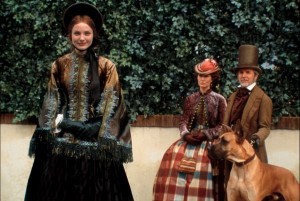
And there was something about the movie's costume designs for men that I found slightly confusing. Mind you, I am not much of an expert on 19th century fashion for men. But for some reason, I found myself wondering if the costumes designed for the male cast were for a movie set in the 1840s or early 1850s, instead of the 1860s, as shown below:

But if I must be honest with myself, I did not like "GANGS OF NEW YORK". Not one bit. The movie proved to be a major disappointment. One of the main problems I had with this film was that Scorsese; along with screenwriters Jay Cocks, Steven Zaillian and Kenneth Lonergan; took what should have been a character-driven period crime drama and transformed it into something nearly unwieldy. When you think about it, "GANGS OF NEW YORK" was basically a fictionalized account of a feud between American-born William Poole and an Irish immigrant named John Morrissey, the former leader of the real "Dead Rabbits" gang. And their feud had played out in the early-to-mid 1850s. Instead, Scorsese and the screenwriters shifted the movie's setting to the early years of the Civil War and ended the narrative with the New York City Draft Riots of 1863 in some attempt to transform what could have been a more intimate period drama into this gargantuan historical epic. I found this perplexing, considering that the Civil War had little to do with the film's main narrative. It also did not help that the film's narrative struck me as a bit choppy, thanks to Scorsese being forced to delete a good deal of the film at the behest of the producers.
I did not have a problem with the conflict/relationship between Bill Cutting and Amsterdam Vallon. I thought Scorsese made an interesting choice by having Amsterdam ingratiate himself into Cutting's inner circle . . . and keeping his true identity a secret. This paid off when Amsterdam saved Cutting from an assassinating attempt, leading the latter to assume the position of the younger man's mentor. At first, I could not understand why Scorsese had included a romantic interest for Amsterdam in the form of a grifter/pickpocket named Jenny Everdeane. In the end, she proved to be a catalyst that led to Amsterdam and Cutting's eventual conflict near the end of the film. One of the few people who knew Amsterdam's true identity was an old childhood acquaintance named Johnny Sirocco, who became infatuated over Jenny. When he became aware of Amsterdam's romance with Jenny, Johnny ratted out his friend's identity to Cutting.
But what followed struck me as . . . confusing. On the 17th anniversary of his father's death, Amsterdam tried to kill Cutting and failed. Instead of killing the younger man in retaliation, Cutting merely wounded Amsterdam, branded the latter's cheek and declared him an outcast in the Five Points neighborhood. An outcast? That was it? I found it hard to believe that a violent and vindictive man like Bill "the Butcher" Cutting would refrain from killing someone who tried to kill him. Perhaps this scenario could have worked if Cutter had tried to kill Amsterdam and fail, allowing the latter to make his escape. Or not. But I found Scorsese's scenario with Amsterdam being banished from Cutting's circle and the Five Points neighborhood to be something of a joke.
As for the movie's performances . . . for me they seemed to range from decent to below average. For a movie that featured some of my favorite actors and actresses, I was surprised that not one performance really impressed me. Not even Daniel Day-Lewis' Oscar nominated performance as William "Bill the Butcher" Cutting. Mind you, Day-Lewis had one or two scenes that impressed - especially one that involved a conversation between Bill the Butcher and Amsterdam, inside a brothel. Otherwise, I felt that the actor was chewing the scenery just a bit too much for my tastes. Leonardo Di Caprio, on the other hand, was crucified by critics and moviegoers for his portrayal of the revenge seeking Amsterdam Vallon. Aside from his questionable Irish accent, I had no real problems with Di Caprio's performance. I simply did not find his character very interesting. Just another kid seeking revenge for the death of his father. What made this desire for revenge ridiculous to me is that Bill the Butcher had killed "Priest" Vallon in a fair fight. Not many critics were that impressed by Cameron Diaz's performance. Aside from her questionable Irish accent, I had no real problems with the actress. I had a bigger problem with her character, Jenny Everdeane. To put it quite frankly, aside from her role serving as a catalyst to Cutting's discovery of Amsterdam's true identity, I found Jenny's role in this movie rather irrelevant.
As for the other members of the cast . . . I found their performances solid, but not particularly noteworthy. I thought Henry Thomas gave a decent performance as the lovelorn and vindictive Johnny Sirocco. The movie featured Jim Broadbent, Roger Ashton-Griffiths, Cara Seymour and Michael Byrne portraying true-life characters like William "Boss" Tweed, P.T. Barnum, Hell Cat Maggie and Horace Greeley. They gave competent performances, but I did not find them particularly memorable. The movie also featured solid performances from the likes of Liam Neeson, John C. Reilly, Brendan Gleeson, Gary Lewis, Lawrence Gilliard Jr., Stephen Graham, Eddie Marsan, David Hemmings, Barbara Bouchet and Alec McCowen. But honestly, I could not think of a performance that I found memorable.
My real problem with "GANGS OF NEW YORK" was Scorsese's handling of the movie's historical background. Quite frankly, I thought it was appalling. I am not referring to the film's visual re-creation of early 1860s Manhattan. I am referring to how Scorsese utilized the movie's mid-19th century historical background for the film. Earlier, I had pointed out that the Civil War setting for "GANGS OF NEW YORK" barely had any impact upon the movie's narrative. I think it may have been a bit in error. Scorsese and the screenwriters did utilize the Civil War setting, but in a very poor manner.
"GANGS OF NEW YORK" should never have been set during the U.S. Civil War. It was a big mistake on Scorsese's part. Day-Lewis’ character is based upon someone who was killed in 1855, six years before the war's outbreak. Scorsese should have considered setting the movie during the late antebellum period, for his handling of the Civil War politics in the movie struck me as very questionable. From Scorsese's point of view in this film, the Union is basically a militaristic entity bent upon not only oppressing the Confederacy, but also its citizens in the North - including immigrants and African-Americans. This view was overtly manifested in two scenes - the U.S. Naval bombing of the Five Points neighborhood during the Draft Riots . . . something that never happened; and a poster featuring the images of both Abraham Lincoln and Frederick Douglass that appeared in the movie:

What made this poster even more ridiculous is that the image of Frederick Douglass was anachronistic. Douglass was roughly around 44 to 45 years old during the movie's time period. He looked at least 15 to 20 years older in the poster.
In "GANGS OF NEW YORK", Americans of Anglo descent like Bill the Butcher were the real bigots of 1860s Manhattan. Not only did they hate immigrants, especially Irish-born immigrants, but also black Americans. I am not claiming that all 19th century Anglo-Americans tolerated blacks and immigrants. Trust me, they did not. But did Scorsese actually expected moviegoers to believe that most of the Irish immigrants were more tolerant of African-Americans than the Anglos? Apparently, he did. He actually portrayed one character, an African-American named Jimmy Spoils, as one of Amsterdam's close friends and a member of the latter's newly reformed "Dead Rabbits" gang. Honestly? It was bad enough that Scorsese's portrayal of Jimmy Spoils was so damn limited. I cannot recall a well-rounded black character in any of his movies. Not one.
Scorsese and his screenwriters made the situation worse by portraying the Irish immigrants as generally more tolerant toward blacks than the Anglos. In fact, the only Irish-born or characters of Irish descent hostile toward African-Americans in the film were those manipulated by Anglos or traitors to their own kind. According to the movie, the violent inflicted upon blacks by Irish immigrants was the instigation of Federal military policy. By embracing this viewpoint, Scorsese seemed unwilling to face the the real hostility that had existed between Irish immigrants and African-Americans years before the draft riots in July 1863. Actually, both the Irish and the Anglo-Americans - "the Natives" - were racist toward the blacks. One group was not more tolerant than the other. The movie also featured Chinese immigrants as background characters. In other words, not one of them was given a speaking part. If Scorsese had really wanted the New York Draft Riots to be the centerpiece of this movie, he should have focused more on race relations and been more honest about it.
I really wish that I had enjoyed "GANGS OF NEW YORK". I really do. I have always been fascinated by U.S. history during the Antebellum and Civil War periods. But after watching this film, I came away with the feeling that Martin Scorsese either had no idea what kind of film that he wanted or that he tried to do too much. Was "GANGS OF NEW YORK" a period crime drama or a historical drama about the events that led to the New York Draft Riots? It seemed as if the director was more interested in his tale about Amsterdam Vallon and William "Bill the Butcher" Cutting. If so, he could have followed the William Poole-John Morrissey conflict more closely, set this film where it truly belonged - in the 1850s - and left the Civil War alone. I believe his handling of the Civil War proved to be a major stumbling block of what could have been an well done film.
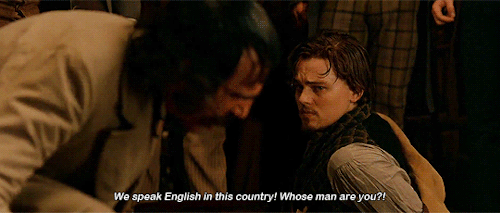
#gangs of new york#u.s. civil war#period drama#costume drama#martin scorsese#new york draft riots#dead rabbits gang#racism#u.s. racism#daniel day lewis#leonardo dicaprio#cameron diaz#john c. reilly#henry thomas#jim broadbent#alec mccowen#david hemmings#liam neeson#roger ashton-griffiths#michael byrne#cara seymour#brendan gleeson#eddie marsan#gary lewis#lawrence gilliard jr.#stephen graham#barbara bouchet
3 notes
·
View notes
Note
Thoughts on X-Men in general and Cyclops in particular?
I went into Cyclops before. The X-Men themselves…hoo boy. If the Fantastic Four are the best superhero team, the X-Men in my eyes are the major group whose popularity is most inversely proportionate to their actual average quality.

To be clear, I totally have loved some X-comics: New X-Men, Whedon’s Astonshing X-Men and Aaron’s work on both the X-Men proper and Wolverine in particular have been great. I’ve lately been in the habit of joking that Wolverine and Emma Frost are their only actual good characters, but while I’ll maintain that they’re the indisputable spectacular standouts of the core bunch, Cyclops and Nightcrawler and Storm and Beast are all good, and on the sidelines Fantomex is downright fantastic. Not to mention I’m biased, since unless it’s Invincible-tier Pulling It Off, soap opera for soap opera’s sake comics are just not my bag in the slightest; same as I’ve been put off by Spider-Man over the years by that formula, the X-Men centering around it automatically distances me. Add that they had already begun their official fall from grace as a triple-A franchise by the time I started regularly collecting comics, and they were probably never going to be a favorite of mine.
I do have a real argument against it though, and it’s twofold: one is that Chris Claremont was not actually very good. Great idea man, when he had time like on God Loves, Man Kills or the original Wolverine mini with Miller he did great work, but on an ongoing basis? I admit the only real substantial chunk of his X-Men I read was Dark Phoenix Saga, but it’s supposed to be the absolute pinnacle of the era and…look, it’s been almost 40 years, we’re all adults, it’s okay to come out and admit that Dark Phoenix Saga sucked, 5 or so great panels aside. Not “it was great for its time, but it hasn’t aged well and its virtues may go unnoticed”, regular old bad comics that left me wondering what the fuck a whole generation of comics readers were collectively hallucinating, no matter how much John Byrne’s art killed it. It tries so hard on a technical basis to be a serious comic for grown-ups, and for individual moments or sequences like Wolverine crawling out of the sewers it works, but it ends up mixed - sometimes even in the same panel - with outright retrograde Silver Age monologuing that utterly destroys the moment, winding up a weird bridge between two eras possessing neither an iota of the charm of what came before it, or the consistent sense of craft that made what came after it work. They reach beyond their station, and take 17 years of that with continuity that doesn’t guard against new readers against picking up X-Men so much as spit on them for even glancing at the franchise, and you’ve got some real shit on your hands. It was an 80s soap opera comic so it has die-hard fans by default who will cling to everything that era stands for forever, but I am absolutely willing to go to bat that on a storytelling basis none of it holds up in the slightest even by the standards of earlier decades (I once told my dad that Gerry Conway was doing better naturalistic superhero comics in Amazing Spider-Man a decade earlier, and I’m still pretty sure he quietly cut me out of his will). And everything about the group since has been built on that run.
The other problem is this scene, which beats the basic premise of the X-Men to a bloody pulp, drags its insensate carcass into a dark alley, puts two rounds in the back of its skull, and leaves its corpse to rot in a drainage ditch.
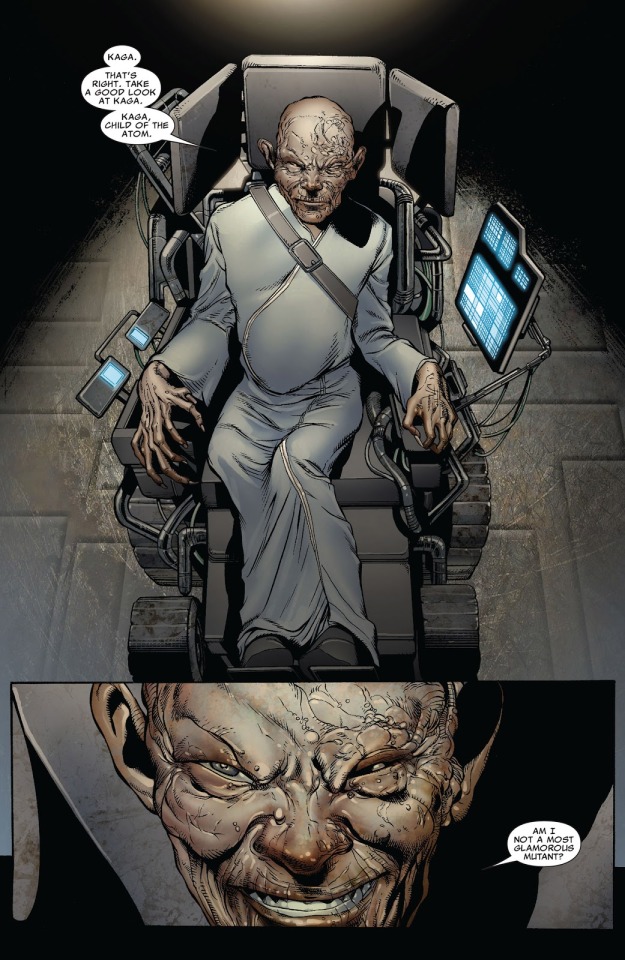


And yeah, that’s about it. The minority/outcast metaphor superhero group is largely a group of gorgeous straight white (or at least white-coded) people who live in a billionaire’s mansion and defeat racism every month by beating up a holocaust survivor before ruminating on whether mutant-on-mutant violence is the real problem, which in the context of the world built around them it actually basically has been for at least the last decade or so. And to boot, when bigots claim they’re dangerous to ‘normal humans’ to drive the racism allegory home, they’re unquestionably right - mutants are mind-shatteringly powerful and dangerous on a planetary and often even galactic scale, with about half of their most prominent public figures pledging to exterminate the entirety of humanity as a species on live television and nearly pulling it off. There are plenty of individual comics that defy that setup and point the way towards something better, but I’d absolutely call that the arc of ‘classic’ X-Men. The most successful attempt I’ve seen at circumventing this was Morrison’s and Aaron’s attempts at reframing them as standing in for youth - as the next stage of evolution it makes sense, it unifies a lot of the disparate strands under a banner of social progression as part of the concept, and that they’re dangerous works because our children will replace us - but that displaces the biggest superhero team standing up as a discriminated group, however poor a job I’d say it typically does with that concept. That legitimate concern paired with regular old fan attachment all but rubs out that possibility, and until and unless the diversity of the group increases to the extent that it needs to, we’re sort of stuck with this foundational problem.
Look, plenty of people whose opinions I respect the hell out of love the X-Men. My dad loves the X-Men, and I’m pretty sure he has something resembling good taste. They’re truly important to people in a way far beyond regular comics fandom, and that makes them important. There’s a real, potent idea in there however buried, a number of cool characters and concepts, and a touch of solid material to build on. I think they can be great. But in terms of the bulk of what’s actually already out there, that so many so dearly love? I do not even kind of get it. Hell, maybe it's just me.
34 notes
·
View notes
Text
New top story from Time: The Best TV Shows of 2020 So Far
No matter what you expected out of 2020, the reality has almost certainly been different. As the coronavirus swept from country to country, making especially brutal landfall in America, even those who remained healthy and employed struggled with loneliness, boredom, anxiety, cabin fever. And in late May, as Americans in major cities faced their third month of quarantine, the senseless death of George Floyd at the hands of a Minneapolis police officer launched a wave of protests against law enforcement’s violence toward the black community. Television, frankly, seems pretty insignificant in the face of both crises. But it did help us stay informed, connected and sometimes even intellectually stimulated at a time when the mere sight of other human faces could serve as an inoculation against loneliness and despair. From the holy agony and ecstasy of The New Pope to the unholy high school terrors of Dare Me, here are 10 shows that helped me weather the first half of this difficult year. Here’s hoping they make whatever you’re living through right now slightly more bearable, too.
Better Call Saul (AMC)
With more and more shows ending or getting canceled after a couple of years, so as not to wear out their welcome in a Peak TV moment infatuated with novelty, Better Call Saul’s fifth season demonstrated the value of patient, thorough character development. It took this long to trace downtrodden public defender Jimmy McGill’s (Bob Odenkirk) transformation into the slick, morally flexible Saul Goodman whom we encountered fully formed in Breaking Bad. In season 5—arguably the series’ best to date—we watched him become a so-called “friend of the cartel,” a designation which earned him a harrowing hike through the Mexican desert with Mike Ehrmantraut (Jonathan Banks), among other brushes with death. But the most exquisitely painful story line traced the impact Saul’s emergence will inevitably have on his partner Kim Wexler (Rhea Seehorn)—a captivating character in her own right, torn between her own capacity for mainstream success and an internal compass more aligned with his outlaw ethics.
Better Things (FX)
youtube
After executing a full, successful third season of her single-parenting dramedy without disgraced co-creator Louis C.K., Pamela Adlon had nothing to prove with season 4. The show loosened up under her solo leadership, adopting the vérité-style rhythms of 20th-century independent films and growing more confident in that meditative style with every episode. Like some of her avant-garde influences, Adlon doesn’t tell discrete stories so much as create scenarios whose themes spark reflection on the part of the viewer. This time around, she had me thinking about the power of friendship among parents (especially divorced moms), the way raising multiple children might feel more like a cycle than a series of individual timelines, how we deal with our anger at people who’ve wronged us but will never take it upon themselves to make amends.
Betty (HBO)
youtube
Crystal Moselle’s adaptation of her wonderful 2018 indie film Skate Kitchen could be Better Things’ little sister. Like that show, Betty, which debuted in May, consists of half-hour episodes that prioritize character-based insights, emotional resonance and dilated moments of crisis and transcendence over tightly constructed plots. But its subject is that glorious, terrifying transition from teenage life to adulthood in the big city, where freedom looks like a skateboard, a fake ID and a little bit of pocket money. Coming-of-age stories are never in short supply, yet the distinctive faces and personalities who make up the show’s central all-female skate crew are like nothing I’ve seen on TV before.
BoJack Horseman (Netflix)
There are great shows that ended badly (Game of Thrones, Lost, Roseanne 1.0), and then there are the divisive finales: The Sopranos, Seinfeld, Mad Men, Girls. Much rarer are series that go out on the perfect note, not just bidding fond farewells to characters viewers have grown to love (or love to hate) but elegantly tying up their most salient themes. When BoJack mastermind Raphael Bob-Waksberg left his titular anthropomorphic horse (voiced by Will Arnett) and the ghost writer who became his most insightful friend (Alison Brie’s Diane) in silence on a rooftop after six excellent seasons, his finale joined the ranks of Six Feet Under, Halt and Catch Fire, M*A*S*H and very few other shows that left us exhausted, tearful and grieving but ultimately satisfied.
Dare Me (USA)
Netflix’s hit docuseries Cheer made cheerleading a TV sensation this winter—which only made it more frustrating that Dare Me attracted so little attention. Set in a Midwestern town whose local real estate magnate (Paul Fitzgerald) is angling to cash in on the talent of a cheer squad that happens to include his two daughters by different wives, this thriller springs to life when he installs a tough, beautiful new coach (Willa Fitzgerald of MTV’s Scream) who challenges the top-girl status of his rebellious eldest child, Beth (Australian actor Marlo Kelly, beguiling). In the center of a conflict marked by escalating violence is Beth’s best friend Addy (The Get Down’s Herizen Guardiola), a quietly determined cheerleader still figuring out who she is. It was a riveting mystery, adapted from co-creator Megan Abbott’s novel, but equally enthralling was its dark, dreamy atmosphere. Before USA canceled it, in April, Dare Me promised to become everything I’d hoped HBO’s more popular, less original teen drama Euphoria would be.
The Great (Hulu)
This period dramedy is about as faithful a depiction of Catherine the Great’s rise to power in 18th-century Russia as Comedy Central spoof Another Period was a document of upper-crust Rhode Island life in Edith Wharton’s time. And that—along with Elle Fanning as a young Catherine, Nicholas Hoult as her debauched imbecile husband Peter III and dialogue from the droll, raunchy mind of The Favourite co-writer Tony McNamara—is what makes it so fun. Like its Oscar-nominated predecessor, The Great is a hilarious satire about gender and power as well as a reminder that European history wasn’t all as polite as Masterpiece miniseries make it out to be.
Mrs. America (FX on Hulu)
You could see the backlash to this all-star historical drama—which earned almost universal acclaim from critics, this one included—coming as soon as it was announced. Creator Dahvi Waller’s nine-part miniseries cast the beloved Cate Blanchett as Phyllis Schlafly, tracing the right-wing ideologue’s origin story in tandem with the implosion of a 1970s feminist movement led by women like Gloria Steinem (Rose Byrne), Shirley Chisholm (Uzo Aduba), Bella Abzug (Margo Martindale) and Betty Friedan (Tracey Ullman). So it was easy for some to accuse the show of making Schlafly too sympathetic. Here’s the thing: depiction isn’t endorsement, and Waller’s inquiry into what made feminism’s most influential female enemy the tyrannical, bigoted, infuriating person she was did not by any stretch of the imagination constitute apologizing for the harm she wrought. On the contrary, this smartly written, beautifully acted and subtly insightful series made it possible for even those of us who find Schlafly’s self-hating views mystifying to imagine how flesh-and-blood humans can devolve into self-serving monsters.
The New Pope (HBO)
youtube
Religion has become an unexpectedly popular subject for TV, in the afterlife comedies that don’t stop coming (The Good Place begat Forever, then Russian Doll, Miracle Workers and most recently Upload), in explorations of identity like Ramy and Unorthodox and in accounts of political conflicts driven by religious differences, from Our Boys to Derry Girls. A sequel to the 2017 miniseries The Young Pope, which took Jude Law’s upstart American Pontiff on a journey from bad faith to true faith, Italian filmmaker Paolo Sorrentino’s The New Pope is something extremely different. With Law’s Pius XIII in some sort of divine coma and Muslim extremists terrorizing Catholic targets, his lieutenants at the Vatican recruit a depressive British cardinal (a tender, delicate John Malkovich) to take his place. Rather than dissecting 21st-century Catholicism, both seasons feel like an attempt to conjure the headspace of religious mysticism, in shots with all the majesty of a Renaissance fresco, a story whose mystery rivals the Book of Revelation and a sense of humor steeped in existential absurdity.
The Plot Against America (HBO)
In 2004, the late giant of American literature Philip Roth imagined an alternate reality in which Charles Lindbergh won the 1940 election, kept the U.S. out of World War II and set about reshaping the country to suit his isolationist, anti-Semitic views. Sixteen years later, with xenophobia, nativism and white supremacy on the rise, Roth’s novel about a Jewish family caught in this nightmare didn’t need much tweaking from The Wire collaborators David Simon and Ed Burns to resonate. The prestige-TV veterans simply stacked the adaptation with an ideal cast (Winona Ryder, John Turturro, Zoe Kazan and Morgan Spector are all spectacular), warmed up its shots with the unnerving golden light of nostalgia and got out of the story’s way… until the very end, which replaced Roth’s too-neat conclusion with something more suitable for 2020.
Vida (Starz)
youtube
It was not Tanya Saracho’s choice to end Vida—the drama she created about two Mexican-American sisters who return home to L.A.’s Boyle Heights neighborhood in the wake of their mother’s death and attempt to save her poorly managed bar—after three seasons. Given just six supersize episodes, a reduced budget and a shortened production schedule with which to complete her expansive meditation on family, community and identity, Saracho and her writers had to do the heartbreaking work of “killing our darlings,” as she put it in a recent interview, to make room for all the “stories we owed.” The result bordered on miraculous: a thoughtful, emotional, sexy season of television that, without feeling rushed, probed mysteries that the sisters’ mom left behind, set every major character on a path of richly deserved growth and ended with a scene that had this viewer crying as hard as the characters themselves.
via https://cutslicedanddiced.wordpress.com/2018/01/24/how-to-prevent-food-from-going-to-waste
0 notes
Text
There's a good list of bad guys called The Irredeemables here. What I'm going to post is derailing. That's why I'm not reblogging my thoughts there and making my own post here. What I'm going to say will miss a lot of points they're trying to make.
Mainly, we need villains to be villains, or we're stuck with the x-men problem where there's barely an effective mutant villain left and every baddie's a bigoted human, society and inhumans who should be protags of their own story, or set pieces to Fantastic Four, and inhumans invented that nobody cares about.
However, here's something to consider: There's irredeemable villains and then there's nazis, which are worse. I don’t know how to make this more clear. There's the villains who kill your loved ones and ruin your life because they make it personal and others die in the crossfire because it got too far and they stopped caring about collateral damage. Then there's nazis who kill people because of what they are and what they represent (Jewish, Romani, political enemies) and will kill anyone they consider undesirable regardless of their victims having lives and loved ones who count on them. It’s one thing to hate the hero and everyone he associates, it’s another to blanket hate a group of people you don’t know. That’s the difference between hating someone on their own merits and punishing them for it and just being bigoted enough to commit genocide. If you can’t discern the difference than I don’t know what to tell you. Not all villain’s evil equally is what I’m saying.
You can enjoy hating a villain, but the moment they become nazi, imperialist, any kind of ist, it's suddenly real and breaks the fantasy and becomes too real for you to enjoy the story because it's mired in reality. It makes you reevaluate and make you sick and the narrative falls apart and you're stuck with a reality check that breaks the narrative.
People who actually enjoy Kylo Ren and don't see the Nazi and imperialist parallels are willfully ignorant, but they can afford to I guess. The symbolism, the marching, the uniforms all so close, but no obvious swastikas to make the willful ignorant uncomfortable.
This brings my point to that stupid Earth-X crossover that should have never existed. When superhero comics had heroes fighting nazis back in the 40's, the villaisn were invented to be nazi's, fifth columnists, or they had nothing to with them because criminality still existed in America's streets regardless of nazi interference. Red Skull's a nazi, Lex Luthor isn't. End of story. You can enjoy Lex's antics and still find him irredeemable because of the lives he's ruined, the people he's killed on the way, but you can get a kick out of how he tries to fuck with Superman today and how Superman will win the odds. You read Red Skull and if he's anything short of a punching bag you feel sick because of what he represents and who he works for.
This brigns my point to fucking CW and there tone deaf bullshit. I was hesitent of them making parallel universe Barry Allen a Nazi. Looks liek they're still going to do it anyway in The Ray cartoon. Whether CW has decided Barry cannot be Jewish because Felicity Smoak was first and it seemed redundant and you know quotas and bullshit, or whether they feel uncomfortable with a black Christian family raising a white Jewish kid, I don't know. Either way, comics Barry has enough source material to go either way on whether he's is, or isn't and the movie verse decided to outright make him Jewish. So watching CW Seed The Ray with a nazi Barry Allen is going to look fucked up to people who watched him in the movies, but that's never stopped CW before.
So getting to my longwinded point. When they annouced Earth-X Flash as being Eobard Thawne with Harrison Wells face, I thought they were going with a parallel universe version of Thawne, but nope. Apparently he's the real deal on the main universe alive and well and working with the nazi's to fuck with Barry and Iris? I honestly didn't watch this crapfest and don't know what there stupid reasoning here is, but what the hell happened to standards?
Once you take a character like Eobard Thawne and align him with Swastikas and concentration camps you cannot be willfully ignorant no more. You cannot enjoy Eobard Thawne's villainous fuckery the next time he inevitably shows up in the tv show and perhaps it now retroactively spills into comics and taints the character and even not he's tainted in fandom now because of this stupid show. More people have watched thsi garbage, or atleast seen the gifsets than have read a comic. Guaranteed. No he's tainted.
I used to hate-love Thawne for his fuckery and gambits back in the comics before he was ever adapted and now because of of the fucking CW he's tainted. Now he's a nazi. A fucking nazi. He's no better than Red Skull. Fuck CW. Fuck CW for deciding Thawne is worse than Joker because that's what they fucking pulled. Joker in the comics gets immunity to being a Nazi because of that John Byrne crossover with Red Skull where as soon as he found out he was working for Hitler hJoker bailed. He may be a psychopath, but he's an American Psychopath, or whatever, I'm summing up. Had Batman been allowed on CW, they would never allowed Joker to be a nazi. Hell they'd probably never allow Lex Luthor to be a nazi because they're too pure in their villainy to be tainted by Nazi politics, but fuck Thawne.
Did the dumbass writer's really think we'd be okay with this? That we'd be glad he's back in any shape, or form once they aligned him with the most vile, evil beings? Do they really think we'll let this slide when he goes back to his petty shit? When he's back threatening Iris with his vibrating hand will it matter in the context of all the Jews and other victims he willingly let die on Earth-X to fuck with Barry and Iris's wedding? Iris starts to seam less important in the grand scheme of things when you add the continuing of the Holocaust and nazi-alliancing as part of this villain's list of crimes. Fuck CW.
0 notes